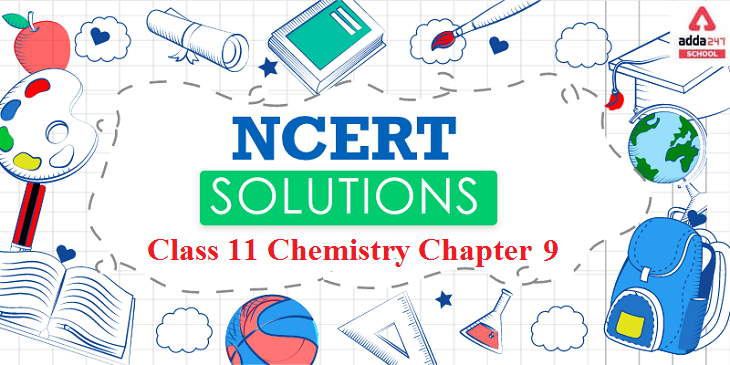Ncert Solutions For Class 11 Chemistry Chapter 9 Pdf Download
Adda247 provides NCERT Solutions for class 11 Chemistry. The NCERT Solutions provided here will enhance the concepts of the students, as well as suggest alternative methods to solve particular problems to the teachers.
Chemistry is much more than the language of Science. We aim to aid the students with answering the questions correctly using logical approach and methodology. The NCERT Solutions provide ample material to enable students to form a good base with the fundamentals of the subject.
Students who are looking for Class 11 Chemistry NCERT Solutions can refer to this article. Students will be provided detailed Class 11 Chemistry NCERT Solutions. Students can find here NCERT Solutions of Class 11 Chemistry PDF in Hindi and English medium.
Students of Class 11 must be through with Science NCERT Class 11 Chemistry Solutions in order to secure good marks in the board exams. These solutions will not only help the students to prepare for board exams but also prepare for competitive medical and engineering entrance exams.
Chemistry is an interesting subject but many of your students might find it confusing to understand. It can be a struggle for many of you.
Benefits of Solutions of NCERT class 11 Chemistry:
- NCERT Solutions for Class 11 is helpful to solve questions from other reference books too.
- NCERT Solutions for class 11 Chemistry will assist students to cross check answers and prepare for the exams in a strategic way.
The students can access the solutions anywhere while browsing web easily. The solutions are very precise and accurate.
NCERT Solutions of Chemistry Class 11 Chapter 9: Hydrogen
Hydrogen is the most abundant in this universe, and thus any knowledge about this element allows one to explore numerous scientific phenomenoa. Keeping this aspect in mind, CBSE has incorporated this topic into their curriculum so that keen students can learn the basic of this element.
Such a topic may seem challenging for students to decipher. In such a synopsis, they can rely on Hydrogen Class 11 Chemistry NCERT Solutions that provide comprehensive guidance on this topic with its eloquent explanation.
With a standard atomic weight of 1.008, hydrogen is the lightest element in the periodic table. Hydrogen is the most abundant chemical substance in the universe, constituting roughly 75% of all baryonic mass. … Hydrogen gas was first artificially produced in the early 16th century by the reaction of acids on metals.
Hydrogen (H), a colourless, odourless, tasteless, flammable gaseous substance that is the simplest member of the family of chemical elements. … Under ordinary conditions, hydrogen gas is a loose aggregation of hydrogen molecules, each consisting of a pair of atoms, a diatomic molecule, H2.
[sso_enhancement_lead_form_manual title=”Download Full PDF of Class 11 Chemistry Chapter 9 ” button =”Download Now” pdf =”/jobs/wp-content/uploads/2021/07/05121548/chapter-9-11th-class.pdf”]
Hydrogen: Uses
Commercial fixation of nitrogen from the air in the Haber ammonia process.
Hydrogenation of fats and oils.
Methanol production, in hydrodealkylation, hydrocracking, and hydrodesulphurization.
Rocket fuel.
Welding.
Production of hydrochloric acid.
Reduction of metallic ores.
Interesting facts about Hydrogen:
Element number one wasn’t the first element discovered.
Hydrogen is the only “neutron-less” element in the universe.
Hydrogen’s presence in water is not the only reason it is essential for life.
Hydrogen already powers everything you use.
The most important function of hydrogen in the human body is to keep you hydrated. Water is made up of hydrogen and oxygen and is absorbed by the cells of the body. Therefore, it is a crucial element which is used not in our body but also as a fuel, in military weapons etc.
How is hydrogen used today? Hydrogen is a very useful element. It is used to make ammonia for fertilizers, refining metals, and methanol for making artificial material like plastics. Hydrogen is also used as a rocket fuel where liquid hydrogen is combined with liquid oxygen to produce a powerful explosion.
Nearly all of the hydrogen consumed in the United States is used by industry for refining petroleum, treating metals, producing fertilizer, and processing foods. U.S. petroleum refineries use hydrogen to lower the sulfur content of fuels.
At very high concentrations in air, hydrogen is a simple asphyxiant gas because of its ability to displace oxygen and cause hypoxia (ACGIH 1991). Hydrogen has no other known toxic activity.
Hydrogen has the highest calorific value so it can be considered as the best fuel but it is highly inflammable so it is diificult to store, transport and handle so it is used as a fuel only where it is absolutely necessary.
Hydrogen is the fuel of the future. … Hydrogen is an energy carrier that can be used in internal combustion engines or fuel cells producing virtually no greenhouse gas emissions when combusted with oxygen. The only significant emission is water vapor.
From this study, we also noted that pure hydrogen gas inhalation had no significant effect on lung function, inflammatory mediators and oxidative production, suggesting that inhalation is a safe method for application.
They’re also more expensive than petrol or diesel. … If you want to buy a hydrogen car outright, it’ll cost considerably more than an equivalent petrol or diesel model, for example the Hyundai Nexo will set you back £66,000.
Battery electric vehicles, or BEVs, are the electric vehicles that most of us are familiar with today, like Teslas. … Fuel-cell vehicles don’t require charging at all. The hydrogen tank is refilled at a hydrogen station in less than five minutes, just like your typical gas station today.
Some of the important topics covered in NCERT Solutions for Class 11 Chemistry Chapter 9 are:
- Dihydrogen (H2)
- Preparation and Properties of Dihydrogen
- Hydrides
- Water Ex
- Hydrogen Peroxide (H2O2)
- Heavy Water (D2O)
- Dihydrogen as a Fuel
Key features of NCERT solutions for Class 11 Chemistry Chapter 9: Hydrogen
- These solutions are in clear and easy language.
- Columns are used wherever necessary.
- Using these solutions, students will be able to address their doubts and conceptual mistakes.
Working out on more and more problems will help students to perform well in class 11 Board exams. NCERT Solution gives the answer to all these exercise in a clear, simple and straightforward way. Students can check their answers with the solutions provided. It is also another way coordination compounds class 11 NCERT solutions help students.
Important questions of NCERT Solutions of Chemistry Class 11 Chapter 9
Question: 1 Justify the position of hydrogen in the periodic table on the basis of its electronic configuration.
Answer:
Hydrogen is the first element of the periodic table & often called protium. Its electronic configuration is [1s1]. Due to the presence of only one electron in its 1s shell, hydrogen exhibits a dual behaviour, i.e., it resembles both alkali metals and halogens. As a result it is placed at the top of the alkali metals in group 1 & also along the halogens in group 17 since just like halogens,it also requires any one electron to have the configuration of the nearest noble gas element..The dual nature of hydrogen can be justified by following points:
Resemblance with alkali metals:
- Like alkali metals, hydrogen contains one valence electron in its valence shell.
H : 1s1
Li : 1s2 2s1
Na : 1s2 2s2 2p6 3s1
Hence, it can lose one electron to form a unipositive ion.
2 Both hydrogen & alkali metals form monovalent cations by losing the electrons in the valence shell, showing hydrogens electropositive character similar to alkali metals.
H à H+ + e- , Na à Na+ + e-
3 In their compounds both hydrogen & alkali metals show +1 oxidation states. Eg Hcl & Nacl 4. Both hydrogen & alkali metals are electropositive in nature,they have affinity for the electronegative elements & readily combine with them & form oxides, halides, and sulphides.
Resemblance with halogens: 1. Both hydrogen and halogens require one electron to complete their octets.
H : 1s1
F : 1s2 2s2 2p5
Cl : 1s2 2s2 2p6 3s2 3p5
Hence, hydrogen can gain one electron to form a uninegative ion.
- Like halogens, it forms a diatomic molecule and several covalent compounds.
Though hydrogen shows some similarity with both alkali metals and halogens, it differs from them on some grounds. Unlike alkali metals, hydrogen does not possess metallic characteristics. On the other hand, it possesses a high ionization enthalpy. Also, it is less reactive than halogens.
Owing to these reasons, hydrogen cannot be placed with alkali metals (group I) or with halogens (group VII). In addition, it was also established that H+ ions cannot exist freely as they are extremely small. H+ ions are always associated with other atoms or molecules. Hence, hydrogen is best placed separately in the periodic table.
Question: 2 Write the names of isotopes of hydrogen. What is the mass ratio of these isotopes?
Answer:
Hydrogen has three isotopes. They are:
- Protium,; 11H
- Deuterium, 12H or D, and
- Tritium, 21H or T
- The mass ratio of protium, deuterium and tritium is 1:2:3.
Question: 3 Why does hydrogen occur in a diatomic form rather than in a monoatomic form under normal condition?
Answer:
The ionisation enthalpy of hydrogen atom is very high. Hence, it is very hard to remove its only electron. As a result, its tendency to exist in the monoatomic form is rather low. Instead, hydrogen forms a covalent bond with another hydrogen atom and exists as a diatomic molecule.
Question: 4 How can the production of dihydrogen, obtained from ‘coal gasification’ be increased?
Answer:
Dihydrogen is produced by coal gasification method as:
C(s) + H2O(g) 1273K CO(g) + H2(g)
The yield of dihydrogen can be increased by reacting carbon monoxide with steam in the presence of iron chromate as a catalyst.
CO(g) + H2O(g) 673K Ctalyst CO2(g) + H2(g)
This reaction is called the water gas shift reaction. Carbon dioxide is removed by scrubbing it with a solution of sodium arsenite.
Question: 5 Describe the bulk preparation of dihydrogen by electrolytic method. What is the role of an electrolyte in this process?
Answer:
Dihydrogen is prepared by the electrolysis of acidified or alkaline water using platinum electrodes. Generally, 15 – 20% of an acid (H2SO4) or a base (NaOH) is used.
Reduction of water occurs at the cathode as:
2H2O + 2e- à 2H2 + 2OH-
At the anode, oxidation of OH-ions takes place as:
2OH- à H2O + ½ O2 + 2e-
: Net reaction can be represented as:
H2O(I) à H2(g) + ½ O2(g)
Electrical conductivity of pure water is very low owing to the absence of ions in it. Therefore, electrolysis of pure water also takes place at a low rate. If an electrolyte such as an acid or a base is added to the process, the rate of electrolysis increases. The addition of the electrolyte makes the ions available in the process for the conduction of electricity and for electrolysis to take place.
Question: 6 Complete the following reaction:
- H2(g) + MmO0(s) heat
- CO(g) + H2(g) heat catalyst
- C3H8(g) + 3H2O(g) catalyst heat
- Zn(s) + NaOH(aq) heat
Answer:
- H2(g) + MmO0(s) heat mM(s) + H2O(l)
- CO(g) + H2(g) heat catalyst CH3OH(l)
- C3H8(g) + 3H2O(g) catalyst heat 3CO(g) + 7H2(g)
- Zn(s) + NaOH(aq) heat NaZnO2(aq) + H2(g)
Question: 7 Describe the consequences of high enthalpy of H-H bond in terms of chemical reactivity of dihydrogen.
Answer:
The ionisation enthalpy of H-H bond is very high. This indicates that hydrogen has a low tendency to form H+ ions. Its ionisation enthalpy value is comparable to that of halogens. Hence, it forms diatomic molecules, hydrides with elements, and a large number of covalent bonds.
Since ionisation enthalpy is very high, hydrogen does not possess metallic characteristics like metals.
Question: 8 What do you understand by the term “non – stoichiometric hydrides”? do you expect this type of the hydrides to be formed by alkali metals? Justify your answer.
Answer:
Non-Stoichiometric hydrides are hydrogen-deficient compounds formed by the reaction of dihydrogen with d-block and f-block elements. These hydrides do not follow the law of constant composition. For example: LaH2.87, YbH2.55, TiH1.5 – 1.8 etc.
Alkali metals form stoichiometric hydrides. These hydrides are ionic in nature. Hydride ions have comparable sizes (208 pm) with alkali metal ions. Hence, strong binding forces exist between the constituting metal and hydride ion. As a result, stoichiometric hydrides are formed.
Alkali metals will not form non-stoichiometric hydrides.
Question: 9 How do you expect the metallic hydrides to be useful for hydrogen storage? Explain.
Answer:
Metallic hydrides are hydrogen deficient i.e., they do not hold the law of constant composition. It has been established that in the hydrides of Ni, Pd, Ce, and Ac, hydrogen occupies the interstitial position in lattices allowing further absorption of hydrogen on these metals. Metals like Pd, Pt etc. have the capacity to accommodate a large volume of hydrogen. Therefore, they are used for the storage of hydrogen and serve as a source of energy.
Question: 10 How does atomic hydrogen or Oxy – hydrogen torch function for cutting and welding purposes? Explain.
Answer:
Atomic hydrogen atoms are produced by the dissociation of dihydrogen with the help of an electric arc. This releases a huge amount of energy. This energy can be used to generate a temperature of 4000K, which is ideal for welding and cutting metals. Hence, atomic hydrogen or oxy – hydrogen torches are used for these purposes. For this reason, atomic hydrogen is allowed to recombine on the surface to be welded to generate the desired temperature.
Frequently asked questions on NCERT Solutions of Chemistry Class 11 Chapter 9
- What are the physical properties of hydrogen according to NCERT Solutions for class 11 Chemistry Chapter 9?
Ans. The physical properties of hydrogen are:
Colourless, odourless, neutral gas
Less soluble in water
Slightly inflammable
Burns with a blue flame
Very low boiling points
- Is it necessary to learn all the questions provided in NCERT Solutions for class 11 Chemistry Chapter 9?
Ans. Yes, to attempt all types of questions which come in exams it is necessary to attempt all the questions provided in NCERT Solutions for Class 11 Chemistry Chapter 9. These solutions are provided in student-friendly language to help you in solving difficult problems in an easier way. These solutions are formulated by experts at Adda247 having good knowledge of Chemistry.
- Is NCERT Solutions for Class 11 Chemistry Chapter 9 Hydrogen important from an exam perspective?
Ans. Yes, all 15 of NCERT Solutions for Class 11 Chemistry are important from an exam perspective. The 9th chapter of NCERT Solutions for Class 11 Chemistry explains hydrogen and its properties of hydrogen. These solutions are available in free PDF format for easy access. Students can view and download these solutions offline as well as online from the Adda247 website.









 ICMAI CMA Foundation Result 2025 Out, Do...
ICMAI CMA Foundation Result 2025 Out, Do...
 NEET UG 2026 Registration: NTA releases ...
NEET UG 2026 Registration: NTA releases ...
 CUET UG 2026 Online Registration Started...
CUET UG 2026 Online Registration Started...














